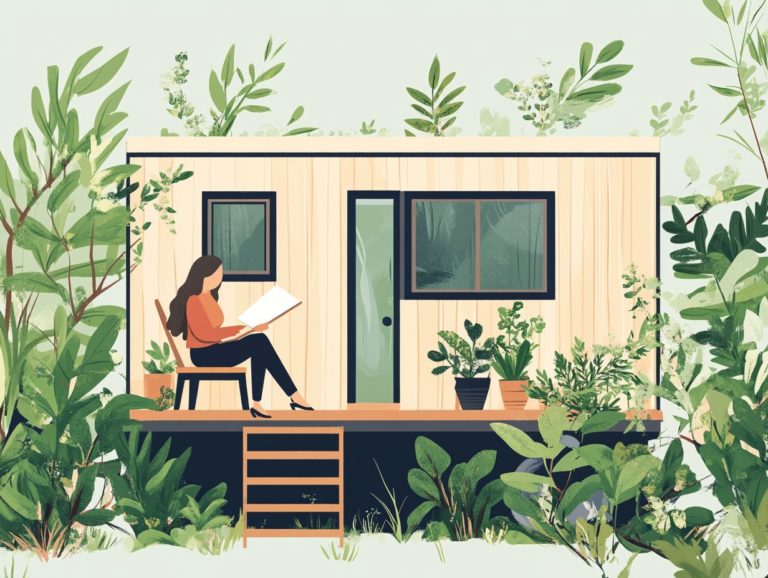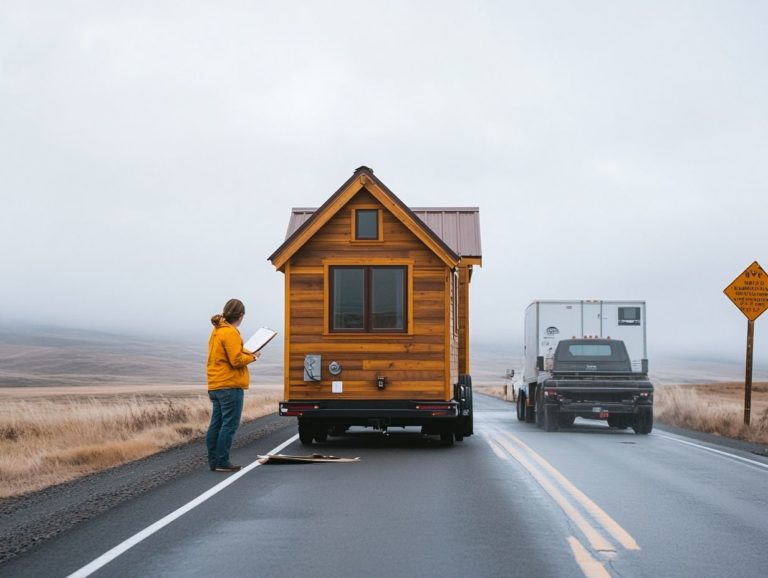How to Address Tiny House Code Violations
Navigating the world of tiny houses can be exhilarating yet daunting, especially when grasping the intricacies of building codes and regulations.
This article highlights the common code violations you, as a tiny house owner, may face ranging from zoning issues to health and safety concerns. It offers practical steps to tackle these violations head-on, guides you on effectively engaging with local authorities, and examines legal options if necessary.
Discover valuable tips for preventing future violations to ensure your tiny home remains a safe and compliant sanctuary.
Contents
- Key Takeaways:
- Tiny House Code Violations: An Overview
- Common Code Violations for Tiny Houses
- How to Address Code Violations
- Working with Local Authorities
- Legal Options for Dealing with Violations
- Preventing Code Violations in the Future
- Frequently Asked Questions
- What is a tiny house code violation?
- How do I know if I have a tiny house code violation?
- What should I do if I have a tiny house code violation?
- Can I appeal a tiny house code violation?
- What are the consequences of not addressing a tiny house code violation?
- What are some common tiny house code violations?
Key Takeaways:

- Understand building codes and regulations for tiny houses to avoid common violations.
- Take prompt and appropriate steps when facing a code violation to address the issue effectively.
- Communicate with local authorities, like building inspectors, to resolve code violations and prevent future ones.
Tiny House Code Violations: An Overview
Tiny house code violations are a pressing issue for city councils across the United States, affecting various aspects of community development and housing initiatives. As tiny homes grow in popularity, local governments are enforcing rules to ensure property owners adhere to established standards.
Let s dive into the common violations you need to know and how these codes impact housing quality and compliance efforts within neighborhoods.
Understanding Building Codes and Regulations for Tiny Houses
Understanding the building codes and regulations for tiny houses is essential for complying with local standards and avoiding potential code violations.
Navigating these codes can be challenging, as they vary widely by locality. Local governments may impose regulations on factors such as minimum square footage, foundation requirements, energy efficiency standards, and zoning laws that dictate where tiny homes can be placed.
For example, some areas may require a tiny house to be at least 120 square feet and affixed to a permanent foundation to qualify as a legal dwelling.
Code enforcement officers are key players in this scenario, ensuring tiny houses meet regulations by conducting inspections and addressing any issues. This oversight protects both homeowners and the community.
Common Code Violations for Tiny Houses
Common code violations for tiny houses often involve challenges with building and zoning regulations, as well as health hazards that could compromise occupant safety.
Building and Zoning Violations
Building and zoning violations pose significant challenges that you, as a tiny home owner, must navigate, complicating community development efforts.
Many cities have minimum lot size requirements that can effectively bar tiny homes from residential areas. Setback regulations rules determining how far your home must be from property lines can further limit placement options, potentially leading to costly renovations or relocations.
Occupancy limits are also critical; they often restrict the number of residents allowed in a tiny home, which can result in overcrowding in alternative accommodations. These violations not only hinder your affordable housing aspirations but can also create tension within neighborhoods, as local residents may perceive tiny homes as disruptive or undesirable.
The repercussions for property owners can be severe, ranging from hefty fines to the daunting prospect of having to dismantle their homes. Now is the time to understand your rights and advocate for policy reevaluation and meaningful community dialogue, especially regarding how to navigate tiny house legalities.
Health and Safety Violations

Health and safety violations present serious risks for tiny homes. These often stem from insufficient housing standards that fail to protect residents from potential hazards.
These risks can take many forms. For example, structural deficiencies can undermine the integrity of the home, potentially leading to dangerous collapses or accidents.
Sanitation issues, including inadequate plumbing and improper waste disposal, create unsanitary living conditions that pose significant health threats. Safety concerns, such as a lack of proper fire exits or ventilation, further complicate the living environment.
Identifying these violations typically requires inspections by local authorities or tenant complaints. This underscores the vital role that adhering to established housing standards plays in safeguarding the well-being of those who choose to reside in these compact living spaces, including understanding tiny house building codes.
How to Address Code Violations
Addressing code violations in tiny homes is crucial! It necessitates a step-by-step plan that includes proactive inspections, clear notifications of violations, and targeted compliance activities tailored for property owners.
By implementing this strategy, you can ensure that your tiny home adheres to all necessary codes and standards.
Steps to Take When Faced with a Violation
When you encounter a code violation, act quickly! It’s essential to understand your obligations and explore remedies through compliance activities.
Start by reviewing the specific violation cited by local authorities. Familiarize yourself with the relevant housing codes that apply to your property.
Engaging in open conversation with your tenants can be invaluable. They might offer insights into the issues that led to the report. Remember to document all communications and actions taken during this process.
Collaborating with local authorities clarifies the requirements. It also demonstrates your commitment to compliance. Address any violations promptly to avoid serious repercussions, including fines or legal actions.
Establishing a clear timeline for resolving these issues is a wise approach to ensure everything is handled efficiently.
Working with Local Authorities
Collaborating with local authorities, such as building inspectors and code officers, is paramount for property owners. By actively engaging with these professionals, you can efficiently address code violations.
This partnership streamlines the resolution process and reinforces your commitment to maintaining high standards in property management.
Communicating and Collaborating with Building Inspectors
Effective communication and collaboration with building inspectors can greatly simplify the process of addressing code violations and achieving compliance with local regulations.
Take the time to familiarize yourself with the inspection process. Recognize that inspectors are not just enforcers of codes but also invaluable resources.
Engaging in open dialogue with them fosters a constructive relationship. This allows for clarifications and discussions about specific requirements.
By asking questions and seeking their advice on corrective measures, you can tap into their expertise to navigate the complexities of housing standards.
Keeping them informed with regular updates and maintaining transparency about ongoing improvements will strengthen this rapport. This ensures everyone is aligned in the pursuit of safety and compliance.
Legal Options for Dealing with Violations

When you encounter significant code violations, you have a range of legal options at your disposal. This includes the ability to appeal the violations and consult with legal counsel to navigate the complexities of housing code issues.
Take steps now to ensure your tiny home is safe and compliant!
Appealing Violations and Seeking Legal Counsel
If you believe the enforcement actions against you are unjust or misapplied, appealing code violations is a viable option for property owners.
This process starts with reviewing the alleged violations. Gather relevant documentation, including photographs, property records, and correspondence from city officials. Pay attention to any deadlines for filing your appeal; missing these could lead to an automatic dismissal of your case.
Legal counsel is essential in this journey. They guide you through each step and ensure that all paperwork is correctly filed and deadlines are met. Their expertise helps you navigate local codes and ordinances, significantly increasing your chances of a successful outcome.
Preventing Code Violations in the Future
To prevent code violations in tiny homes, you must actively take steps. Familiarize yourself with local housing standards, identify potential safety threats, and utilize educational resources available to you.
This preparation ensures compliance while enhancing the overall safety and integrity of your tiny living space.
Tips for Staying Compliant with Codes and Regulations
Staying compliant with codes and regulations is crucial for tiny homeowners. This helps you avoid potential violations and ensures your property meets safety and quality standards.
Actively participating in regular inspections allows you to spot and address issues before they escalate. Understanding your maintenance responsibilities enables you to uphold the integrity of your home while adhering to local ordinances.
Stay informed about changes to housing codes, as regulations can shift over time. Seek local resources like community workshops or legal advice for education and support.
Engaging with local networks offers valuable insights from fellow tiny home enthusiasts who have navigated similar challenges.
Frequently Asked Questions
What is a tiny house code violation?

A tiny house code violation means not following the building rules for tiny houses. This can involve issues with zoning, size, safety, and other requirements.
How do I know if I have a tiny house code violation?
If you received a notice from your local government or building department, it’s likely you have a code violation. Check the building codes for your area to confirm your tiny house meets all requirements.
What should I do if I have a tiny house code violation?
Contact your local government or building department to understand the specific violation and steps needed to address it. They will guide you on how to bring your tiny house into compliance.
Can I appeal a tiny house code violation?
Yes, you can appeal a code violation. First, understand the violation and work with your local government to resolve the issue. If you believe it’s unjust, you can file an appeal.
What are the consequences of not addressing a tiny house code violation?
Ignoring a tiny house code violation can lead to fines, legal action, and even eviction. Address any violations quickly to avoid these consequences.
What are some common tiny house code violations?
Common tiny house code violations include improper zoning, lack of proper permits, inadequate size requirements, and not meeting housing standards. Research and understand all building codes and regulations before constructing your tiny house.
If you suspect you have a code violation, seek professional help or further information immediately to protect your home!






